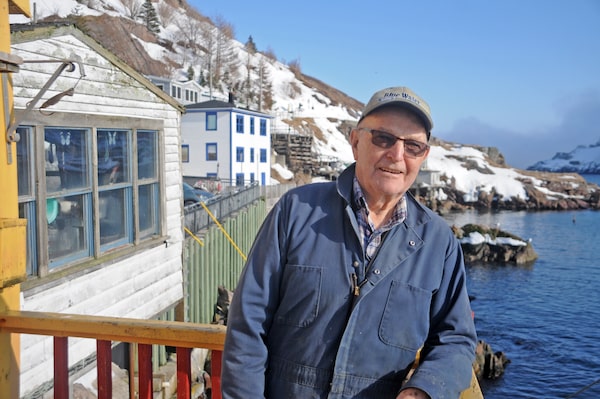
Newfoundland fisherman Charlie Pearcey, undated.Andrew Robinson/The Telegram
Charles Pearcey (always called Charlie) was proprietor of the Twine Store, a globally recognized heritage site in the Battery neighbourhood of St. John’s. Also a survivor of the Feb. 16, 1959, Signal Hill avalanche, which killed five people, three in his own family, he embodied much of the Battery’s history. This colourful cluster of houses clinging to iconic Signal Hill is an outport within the city, where the inshore fishery was prosecuted with handlines and fixed gear. Mr. Pearcey, born and raised there, represented the fourth generation of independent fishers in his family.
Pearcey’s Twine Store and Stage, painted red with yellow trim, was originally a property for storing fishing gear, with harbour access. It was built by Mr. Pearcey’s uncle Robert in 1956, the latest in a series on the site dating back to 1891. After Mr. Pearcey took early retirement in 1993, he “turned it into a family museum,” his son Blair said. It was filled with nets, gear, gaffs, block and tackle, squid jiggers, grapnels and collars (all labelled), archival photos and carvings by Robert, a talented folk artist. Here Mr. Pearcey shared his knowledge of landmarks, trap berths, boat handling skills, “making fish,” boatbuilding, and building stores, stages, wharves and flakes – the disappearing skills and infrastructure of the inshore fishery.
Not an official tourist destination, the Twine Store kept its door invitingly open so people on the Outer Battery road to Signal Hill’s North Head Trail would simply wander inside. Fifteen guest books held thousands of signatures from all over the world. In 2014, the Provincial Historic Commemorations Program designated Mr. Pearcey as a tradition-bearer, and he was often interviewed for print and film.
The Twine Store was his only physical connection to the Battery. His family home had been destroyed by the avalanche, which careered down the Battery shortly after 1 a.m. that fierce February night. “The 1959 avalanche wasn’t the worst in Newfoundland, but it’s the best known,” said David Liverman, author of Killer Snow: Avalanches in Newfoundland and Labrador (2007). “It was within living memory.”
Then 21, Mr. Pearcey had gone to church on Cochrane Street and it was so stormy when he got home that he parked his car at the bottom of Signal Hill and walked up through the snow. “And my brother, my sister, my mother, my father, my grandmother, we all went to bed about 10 o’clock, 11 o’clock, with the snow coming down, heavy snow,” he told Angela Grant, one of Dr. Liverman’s researchers.
Winds were peaking at 217 kilometres an hour. More than 51 centimetres of snow fell. Power was lost throughout the Avalon Peninsula, even firefighters were snowbound, and the U.S. military base at Fort Pepperrell declared a state of emergency.
“I don’t remember anything till the avalanche hit. My sister [Gloria, and brother, Carl] ended up on the road. My mother, my father, and my grandmother were underneath the roof of the house.”
Mr. Pearcey was among the dozen people buried, even as the storm’s intensity hampered rescue efforts. “I thought I was dreaming that I couldn’t get out and couldn’t even move,” he told the Telegram in January after “Snowmageddon” caused another avalanche in the Battery. “I don’t know how long I was there.”
His parents, James, 47, and Ethel (née Vincent), 43, died in each other’s arms. His grandmother, Judith Vincent, 76, was also killed, while among his neighbours Edward (Ted) Wells, 17, perished, and Isaiah Dawe, 100, was taken to hospital and died the next day.
Mr. Pearcey moved in with his uncle Robert after the avalanche, and helped look after his brother, Carl, and sister, Gloria, then both teenagers. He graduated from Macpherson school and worked at the General Hospital before becoming head of the credit department with Golden Eagle (now Ultramar).
When he died of a brain aneurysm on April 18, aged 82, comedian Mark Critch tweeted, “St. John’s lost one of its greatest ambassadors.” His Twine loft “was a museum and he was the best guide you could ever have.” He leaves his wife, Avril (née Pear), with whom he had just celebrated their 58th wedding anniversary on April 7; as well as his daughter, Carleen; sons, Blair and Christopher; and siblings, Carl and Gloria.
The family intends to keep the Twine Store going, Blair Pearcey said.
Charles Samuel Moses Pearcey was born on April 26, 1937. His father, James, had been the main skipper of the family enterprise, and Charlie had fished with him in the summers. After the avalanche, Charlie’s two uncles, Robert and Ernest, fished for a time, but they soon sold their shares and switched occupations.
Although Mr. Pearcey now lived “up in town,” the Battery remained a special and significant place for him. “I have my stage, my store here for family reasons,” he told Ms. Grant. “This is where I was born to. It’s my heritage out here. But I’ll never go back to live in that spot.
“Life goes on for everybody and you just keep going, right? It’s just one of those freaks of nature that something happened. It happened.”
“It made me realize the real impact, hearing Charlie talk about and relive the event,” Dr. Liverman said. “It was very emotional. He was very open about it. Just an extremely nice man.”